Capitalism rules
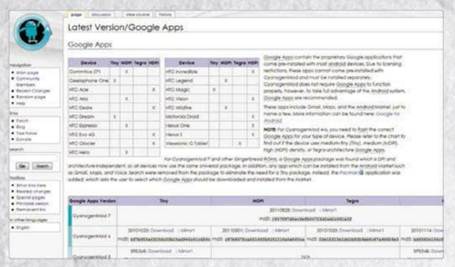
Capitalism
rules
For legal reasons, Google Play and other
Google apps can’t be included in custom builds of Android and must be installed
separately. If you haven’t already connected to your wireless network, open a
browser and go to www.bit.ly/9E29YP.
This is the CyanogeMod 9 ICS will be there soon, too.
Reboot disappointment

Reboot
disappointment
The Archos system is set to auto-install
the Google App zip file you downloaded after a reboot. This instigates a fresh
installation sequence and sets up the Market. You may notice that not all the
apps you’d expect are available. This is glitch that affects emulators and
custom builds, but there is sometimes a way around it.
Market hack

Market
hack
To improve the selection of apps, open
‘Settings’ and select ‘Applications > Manage applications > All’. Find
the Market, click ‘Force stop’ if available and then ‘Clear cache’, but not
‘Clear data’. Return to the list, now locate ‘Google Services Framework’ and
select ‘Clear data’. Reboot, then start the Market for a wider selection.
Upgrade android
Archos! Bless you

Archos!
Bless you
Archos tablets go by various names, but
most devs refer to them by generational names. So the Archos 5 and 7 IMT are
Gen6 devices. The Archos 5 IT is Gen7 and the Archos 101, 80 and 70 are Gen8.
Go to www.archos.com and select ‘Support
> Downloads and special developer edition firmware.’ Grab the version for
your device.
One step beyond
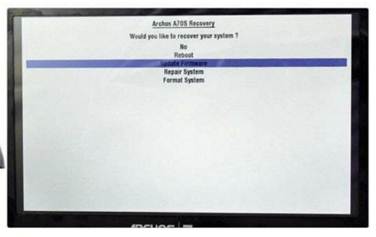
One
step beyond
Warning: flashing the SDE invalidates the
warranty and removes the ability to play DRM content. To install the SDE, power
off the Archos, then turn it on while holding volume down. The Archos screen
appears and then the white Recovery mode appears. Use volume buttons to highlight
‘Update firmware’ and power button to select it.
Custom modes

Custom
modes
Connect the Archos to your PC via its USB
port and make sure it’s powered from the mains adaptor. Copy the downloaded AOS
file to the root of the Archos drive. Eject the device from Windows and press
the power button to install the SDE. To boot the alternative OS when powering
up or rebooting, hold down both volume buttons.
Flash master
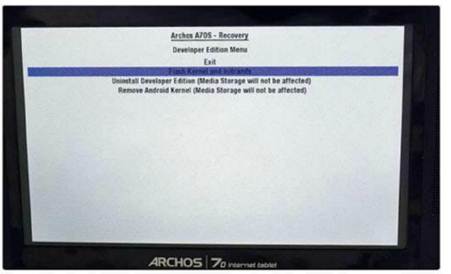
Flash
master
Go to www.bit.ly/sXWO4S
to get the latest version of zlmage and initramfs. Boot the Archos into
recovery mode and select ‘Recovery system > Developer edition menu >
Flash kernel and initramfs.’ Connect it to your PC and copy both files to the
root of the Archos. Unmounts the Archos and let the tablet install and reboot.
Gingerbread device

Gingerbread
device
Get the build for your tablet from www.bit.ly/uokKrL. Connect the tablet to
the PC and boot into Recovery boot. Select ‘Recovery system > Repair system
> Start USB MSC’. Copy the file to the root of the tablet, name it
openaos-gingerbread.img.gz and eject the device. Press the power button and
pick ‘Reboot.’
Boot me

Boot
me
Hold both volume button to select the Development
Mode boot. If you named the Gingerbread file correctly, it will be list. Select
it with the power button and Android will appear so you can run through the
standard setup. Follow the guides adding Android Market and getting the best
from CyanogenMod.
Cyanogenmod overclockings
Built-in controls

Built-in
controls
CyanogenMod provides a performance section.
Select ‘Settings > CyanogenMod settings > Performance > CPU settings’.
You’ll find maximum and minimum values for CPU speed; it’s best to keep the
minimum at the lowest, but ramp up the max as far as you like. The Archos
defaults to 800MHZ, but the CPU is designed to run at 1GHZ.
Alright Governor

Alright
Governor
The governor dictates how the tablet
controls the CPU speed. Conservative increases the speed slowly and decreases
faster, saving power. Performance ramps up quickly and down slowly, using more
power. Ondemand is a binary straight to maximum and minimum, while Interactive
provides a real-time response to CPU demand.
Custom tools
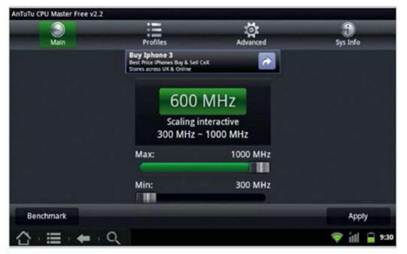
Custom
tools
Google Play and other platforms provide
additional overclocking tools, however the range of frequencies they offer is
still dictated by the installed OS. Many, including AnTuTu CPU Master, provide
Governor-style controls to help you eke out more battery performance or
mitigate any impact overclocking has on battery life.
Battery optimization
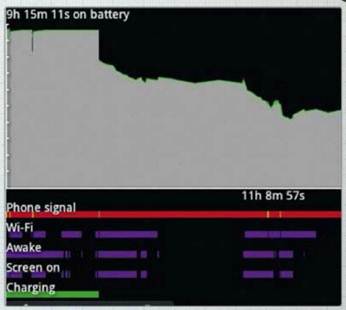
Learn
what the biggest battery drain is and cut back; adjust the screen’s brightness
or turn off Wi-Fi
Something all manufacturers need to learn
from Apple is that to get the best possible device in terms of battery life,
you have to get the OS to play as nicely as possible with the hardware. We’re
tried devices with early alpha ports of Android, and due to issues with
wireless adaptor drivers, sleep modes, screen drivers and so on, battery life
is a couple of hours at best. Compare that with an iPad’s run time of up to 10
hours playing video and a week on standby…
The good news is that these are usually temporary
issues, because developers can tweak these problems out. Even so, you may need
to disable the wireless to help extend sleep battery life. There are several
apps that can help automate these tasks, depending on whether you take the
tablet out and about. Juice Defender is a good option. This comes in a number
of free and paid-for options with more features, including location-aware
toggles. A simpler option is the free Auto WiFi Toggle, which enables you to
specify schedules and behavior for when and how the wireless should be used.
Simply turning off a tablet’s wireless adaptor can help extend battery life
from a day to almost a week.
An ageing Android
The number of Android devices can be
bewildering, and the number of versions of the Android OS beyond the standard
releases from Google, known as fragmentation, even more so. While it’s often
referred to in a negative way, fragmentation is one of Android’s strengths,
enabling custom versions and cheaper devices to be released. The low cost comes
partly from not bothering to support a device once it’s released. Thanks guys!
The original versions of Android are v1.1,
v1.5 Cupcake and v1.6 Donut. Incredibly, v1.6 devices were still around even in
2011. We strongly recommend against these versions. Android 2.0 Éclair is where
things get interesting, with v2.2 Froyo being really the lowest version you
want, as it offers many advanced features such as Wi-Fi hotspots. Currently,
2.3.7 is the latest release of Android v2.3.x Gingerbread, and it includes a
lot of optimizations. Android v3.x Honeycomb was rushed out for the original
Android tablets, and the source was never released publicly because Google
wanted a single build for all devices. That build is Ice Cream Sandwich, also
known as Android 4.0. We expect most current devices to get an official or
homebrew upgrade – the base specification is any device with 256MB of memory
and a suitable GPU.
Hackable hardware choices

The
dual-core HP TouchPad was the best-selling non-Apple tablet when discounted to
$148.5 last year
We’ve chosen the Archos 70 Tablet for two
reasons: it can be picked up for $150 from Carphone Warehouse and it has an
active hacking community. That price gets you a capacitive 7-inch tablet with a
1GHz ARM processor and 256MB of memory, 8GB storage with SD card expansion.
This is everything you need from a basic tablet. There are cheaper models, but
these tend to have horrible resistive screens, less internal storage and slower
processor. More importantly, they may not have an active community behind them.
But what other options are there? To start,
consider the Archos 101 internet tablet, it’s a 10.1-inch version of the Archos
70, but specifically enables dual-booting so you can install any suitable OS you
like. It can be picked up for around $225 from certain suppliers. If you want
something faster, the HP TouchPad is a dual-core system that has an active
community working on an Android 4.0 port. As HP no longer make these, it’s
harder to pick them up from anywhere other than eBay. Another good dual-core
choice is the Advent Vega from PC World. It has a good molding community and
can be bought for around $298.5 or less when on offer.